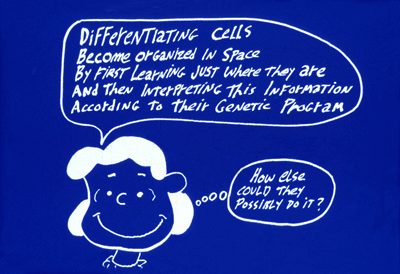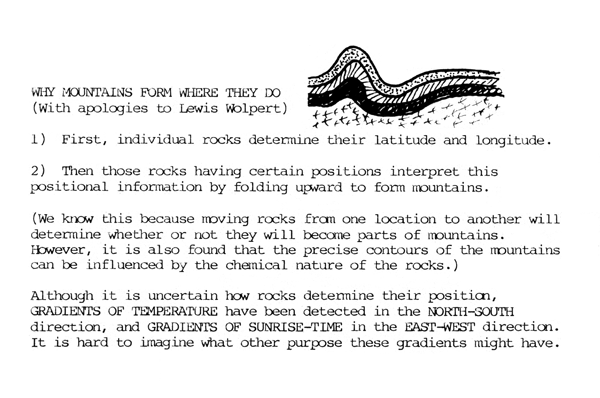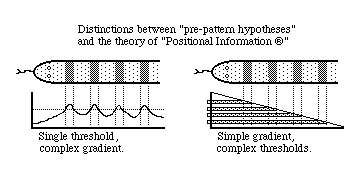Cellular Slime Molds
such as Dictyostelium discoideum
(a species that was discovered by a UNC graduate, Kenneth Raper)
-
Dictyostelium aggregation
The surprising life cycle of cellular slime molds:
a) Live as small amoebae, eat bacteria.b) These amoebae divide mitotically.
c) When they run out of food, the amoebae...
-
1) secrete cyclic AMP
2) become chemotactically attracted to cyclic AMP
(so that amoebae attract each other)
3) develop a selective cell-cell adhesion protein
(so that amoebae stick to each other)
(with as many as hundreds of thousands of cells,
or as few as hundreds of cells, or even fewer)
[not the same as the kind of shell-less snail called slugs]
e) These "slugs" crawl around for a few hours
f) Amoebae then differentiate into...
-
* Stalk cells
* Spore cells
* "base cells"
h) Spores land somewhere, and amoebae hatch out.
Dictyostelium is one of the most widely studied "model" research organisms, with hundreds of research labs around the world concentrating on this one species.
Advantages include:
-
Differentiating into only 4 cell types
Many mutant strains
The form of "amoeboid locomotion" most like our cells'
When you cut the slugs in 2, or 100, they" regulate"

--------------------------------------------------------------------------------------------------------------
What can scientists conclude from Driesch's phenomenon?
("Regulation" in the embryological sense)BUT, BEFORE ANSWERING THAT QUESTION, let's vote about the following: Which do you believe?
#1) If scientists understood the underlying mechanisms of embryonic development (that form anatomical patterns and all that) then we would have been able to predict Driesch's results, before doing those experiments!
Vote count: Yes? a few shy students No? Dozens of confident votes _
#2) Unless a theory of development can explain regulation, then it can't be the correct explanation of normal development, either?
Vote count: Yes? 3, counting me_ No 29_students
[Apparently, the majority of members of this class believe that "regulation" (such as the development of separated cells into larvae) is caused by some different mechanism(s), different from the one(s) that create body structures during normal development, when no experimenter has separated early cells.]
#3) A correct theory should also be able to explain why development of many organisms is mosaic?
And provide criteria to predict which species will have mosaic development, & which species will have regulative development.
Like, maybe, based on looking at their genome?
Vote count: Yes 47 No 0
[This majority also claims to believe that inability to "regulate" IS caused by the normal mechanism of development!]
#4) Regeneration by cut-in-two flatworms and Hydras
should also be regarded as (=defined as?) regulation.
Vote count: Yes ______ No ______ vote not held
#6) Nematodes have very poor wound-repair;
Vote count: Yes 43 No 6
[In this case, I agree with the majority]
But Sea Squirts and molluscs have good wound repair? !!
Because the mechanism must be basically the same?
For some other reason?
(For those who would have voted "Yes" about question #4)
#5) Then why can't humans regenerate when cut in two?
(Since our early embryos are so regulative?)
This is probably for the same reason that their
development is so mosaic!
#7) WHICH OF THE FOLLOWING DO YOU TEND TO BELIEVE?
Entirely new kinds of phenomena will probably be needed for researchers to understand regulation? 20 votes
OR?
The true explanation will probably seem very simple once we think of it, and work by known phenomena, (that have already been discovered) like diffusion. 55 votes
Vote count: Entirely new: 20 students believe this.
Simple, already known: 55 students believe this.
#8) The best way to discover the mechanisms of incomprehensible phenomena is to concentrate research on those organisms in which these phenomena occur the least. (e.g. nematode embryos can't regulate) That way, you avoid stuff you don't understand!
Vote count: Makes sense to me!______
No? ________
Ron Paul _____
Kucinich_____
***********************************************************************
A) Many embryologists believe that regulation just means that cell fate is decided late in development.
They think that mosaic development just means early determination of cell fates.
B) Other embryologists argue that if cell fate is decided very early, at the time of cleavage, then it's controlled by some mechanism that puts some different signal into cells before they cleave,
whereas regulative development means they depend more on cell -> cell signals, that are sent and received after cleavage.
C) The "Positional Information Theory"
(that was invented by Lewis Wolpert)
explains regulation by a combination of x, y & z
coordinate axes (caused by chemical gradients),
with each cell deciding how to differentiate based
on its local measurements of the x, y, z variables.


The textbook author likes this theory, so do many others;
but not me.
But it attracted many good people to embryology.


D) Hans Driesch himself concluded that his results disproved all possible chemical and physical mechanisms, and therefore proved that development is controlled by a supernatural, 'mind-like' "Entelechy".
But please don't tell the "intelligent design" folks about this.
Driesch was very serious about this belief, and resigned his Biology job, became a Philosophy professor, and wrote books about the entelechy concept, and related subjects.
E) My PhD thesis advisor, the late J.P.Trinkaus often joked that regulation proves that embryos must have not just one, but 2 or 4 entelechies, one for each of the fragments, & mosaic development is an entelechy deficiency.
**********************************************************
Please notice the fundamental difference between Wolpert's "Positional Information"
In contrast to the idea of chemical "prepatterns".
These are very different ideas.

Turing's mechanism, Liesegang rings and other "reaction-diffusion systems" are hypothetical ways to generate prepatterns.
>>>>>>>>>>>>>>>>>>>>>>>>>>>>>>>>>>>>>>>>>>>>>>>>>>>>>>>>>>>>>>
Additional thoughts about regulation:
Notice that when you cut a spherical water drop in two, the two fragments each become smaller spheres.
If surface tension could somehow cause drops to be cubes, then cutting one cube in two might also result in the two fragments each becoming a smaller cube.
(But cubic crystals don't "regulate" when cut in two! nor do any other shape crystals)
Slime mold slugs have (somewhat!) consistent length/width ratios (~8) and are nearly round in cross sections.
The immediate resonse of a slime mold slug to being cut into fragments is (unless already fruiting) for the fragments to elongate or narrow just enough to restore the 8:1 length/width ratio.
The length/width ratio can be changed by mutations and by feeding unusual diets, both of which also cause changes in ratios of numbers of cells that differentiate into stalk cells versus spore cells.
Flat-worms and Hydras also respond to being cut in pieces by rearraging their remaining cells so as to restore approximately their original length/width ratios.